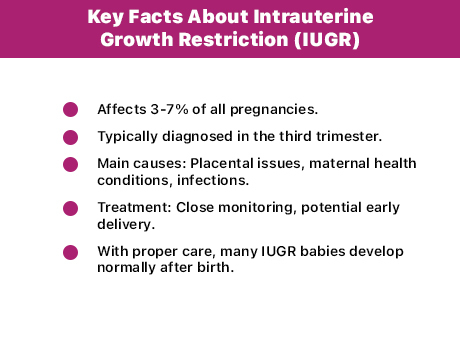
Intrauterine Growth Restriction (IUGR)
Intrauterine Growth Restriction (IUGR) occurs when a baby in the womb is not growing at the expected rate, particularly in the third trimester, often weighing less than 90% of babies at the same gestational age. This slowed growth can lead to significant health risks, including low birth weight, difficulty breathing, or developmental delays after birth. IUGR limits the baby’s access to essential nutrients and oxygen, affecting their overall well-being. Understanding the causes and symptoms of IUGR is crucial, as early detection can lead to better management and improved outcomes for the baby. By staying informed and working with healthcare providers, parents can take proactive steps to protect their baby’s health during pregnancy. Knowing the potential threats posed by Intrauterine Growth Restriction, such as stillbirth, preterm delivery, or complications after birth, emphasizes the importance of monitoring fetal growth closely. Early intervention and specialized care can make all the difference, ensuring the best possible outcome for both mother and baby. So, let's explore the condition in detail.

Common Intrauterine Growth Restriction Causes
There are various Intrauterine Growth Restriction causes, and they can differ from one pregnancy to another. Some of the most common reasons for IUGR include:
- Placental issues: The placenta may not provide enough oxygen or nutrients to the baby.
- Preeclampsia: High blood pressure in the mother can restrict the baby’s growth.
- Infections: Certain infections can lead to Fetal growth restriction.
- Multiple pregnancies: Conditions like twin to twin transfusion syndrome can result in uneven nutrient distribution between twins.
- Maternal health conditions: Chronic illnesses such as diabetes or kidney disease may impact the baby’s growth.
Understanding these causes helps in tailoring treatments and interventions that can improve outcomes for both the mother and the baby.
IUGR Symptoms to Look Out For
Often, there are no visible symptoms for IUGR. The condition is typically identified through routine prenatal ultrasounds that measure the baby’s growth. However, there are some indicators that might suggest the presence of Fetal growth restriction:
- The baby’s size appears smaller than expected for their gestational age.
- A reduction in the amount of amniotic fluid.
- Reduced movement of the baby in the womb.
If your healthcare provider suspects IUGR, they may recommend additional tests to monitor your baby’s well-being closely.
Can IUGR Babies Be Normal?
One of the most common questions parents ask is, Can IUGR babies be normal? The reassuring answer is that many babies with IUGR go on to develop normally, especially with timely medical interventions. However, these babies may be at a higher risk for certain health issues at birth, such as low blood sugar or breathing difficulties, and may require extra monitoring in a neonatal care unit.
With proper medical care, including early diagnosis and treatment, the chances of your baby leading a healthy life are greatly improved. For more complex conditions like twin to twin transfusion syndrome treatment or preeclampsia treatment, The Garbh offers specialized fetal medicine services to ensure that both mother and baby receive the care they need.
How is IUGR Diagnosed?
Diagnosis of Intrauterine Growth Restriction often begins with routine ultrasounds during the third trimester. If your doctor suspects IUGR, they may recommend:
- Doppler ultrasound: Measures blood flow through the placenta and umbilical cord.
- Non-stress test: Monitors your baby’s heart rate.
- Biophysical profile (BPP): Assesses fetal health through ultrasound and monitoring.
These diagnostic tools help your healthcare provider to evaluate the baby’s growth patterns and decide on the best course of action.
Treatment Options for IUGR
The treatment of IUGR depends on the severity of the condition and the underlying causes. Some potential treatment options include:
- Frequent monitoring: Your doctor may recommend regular ultrasounds to track the baby’s growth and amniotic fluid levels.
- Bed rest: In some cases, bed rest can improve blood flow to the placenta, which can help the baby grow.
- Early delivery: If the baby’s health is at risk, your doctor may recommend delivering the baby early to ensure proper care outside the womb.
At Garbh, we offer comprehensive IUGR treatment plans to address the specific needs of each pregnancy. Our experienced team, including specialists in fetal medicine, provides guidance and support throughout the process.
Steps You Can Take to Prevent IUGR
While not all cases of Intrauterine Growth Restriction are preventable, there are steps that expecting mothers can take to minimize the risk:
- Proper prenatal care: Regular checkups can help detect potential issues early.
- Healthy diet: Ensure that you’re eating nutrient-rich foods to support your baby’s growth.
- Manage chronic conditions: If you have conditions like high blood pressure or diabetes, work closely with your healthcare provider to manage them effectively.
At Garbh, our services include personalized care plans and treatments, such as preeclampsia treatment, to help mothers manage their health and support their baby’s growth.
Conclusion
If you’re expecting and have concerns about your baby’s growth, understanding Intrauterine Growth Restriction is very important. While the condition may sound intimidating, timely diagnosis and appropriate care can make all the difference. At Garbh, the best fetal medicine centre in Chandigarh, our dedicated team of specialists is here to guide you every step of the way, providing comprehensive services from IUGR treatment to advanced preeclampsia treatment and care for conditions like twin to twin transfusion syndrome.
Take control of your pregnancy journey with personalized care at Garbh. Our expert team is here to support you and your baby, ensuring the healthiest outcome possible. Contact us today to schedule a consultation or learn more about how we can help you!
FAQs
How is IUGR different from low birth weight?
Ans. While IUGR refers to slow growth in the womb, low birth weight simply means the baby is born smaller than average. However, babies with IUGR may have low birth weight.
What is fetal medicine and how does it relate to IUGR?
Ans. Fetal medicine focuses on the diagnosis and treatment of unborn babies. At Garbh, we offer specialized care for conditions like Intrauterine Growth Restriction, helping to manage the health of both mother and child.
What happens if my baby is diagnosed with IUGR in the third trimester?
Ans. Your doctor will closely monitor your pregnancy, and depending on the severity of the condition, may recommend treatments or early delivery to ensure your baby’s health.
Can IUGR affect twins?
Ans. Yes, twins are at a higher risk for IUGR, especially if they experience twin to twin transfusion syndrome. Specialized treatment, like the ones offered at Garbh, can help manage this condition.
Is there a Fetal Medicine Centre in Chandigarh for IUGR treatment?
Ans. Yes, The Garbh provides specialized care and IUGR treatment at our state-of-the-art Fetal Medicine Centre in Chandigarh, offering the highest standard of care for expecting mothers and their babies.

